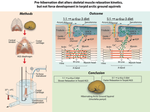Journal of Comparative Physiology B ( IF 1.7 ) Pub Date : 2024-01-14 , DOI: 10.1007/s00360-023-01527-z Jishnu K S Krishnan 1 , Sarah Rice 1, 2 , Monica Mikes 2 , M Hoshi Sugiura 2 , Kelly L Drew 1, 2 , Zeinab Barati 2 , S Ryan Oliver 1, 3

|
During the hibernation season, Arctic ground squirrels (AGS) experience extreme temperature fluctuations (body temperature, Tb, as low as − 3 °C), during which they are mostly physically inactive. Once Tb reaches ~ 15 °C during interbout arousals, hibernators recruit skeletal muscle (SkM) for shivering thermogenesis to reach Tb of ~ 35 °C. Polyunsaturated fatty acids (PUFA) in the diet are known to influence SkM function and metabolism. Recent studies in the cardiac muscle of hibernators have revealed that increased levels of ω-6 and the ω-6:ω-3 PUFA ratio correlate with sarco/endoplasmic reticulum calcium ATPase (SERCA) activity and hibernation status. We hypothesized that diet (increased ω-6:ω-3 PUFA ratio) and torpor status are important in the regulation of the SERCA pump and that this may improve SkM performance during hibernation. Ex vivo functional assays were used to characterize performance changes in SkM (diaphragm) from AGS fed the following diets. (1) Standard rodent chow with an ω-6:ω-3 ratio of 5:1, or (2) a balanced diet with an ω-6:ω-3 ratio of 1:1 that roughly mimics wild diet. We collected diaphragms at three different stages of hibernation (early torpor, late torpor, and arousal) and evaluated muscle function under hypothermic temperature stress at 4 °C, 15 °C, 25 °C, and 37 °C to determine functional resilience. Our data show that torpid animals fed standard rodent chow have faster SkM relaxation when compared to the balanced diet animals. Furthermore, we discovered that standard rodent chow AGS during torpor has higher SkM relaxation kinetics, but this effect of torpor is eliminated in balanced diet AGS. Interestingly, neither diet nor torpor influenced the rate of force development (rate of calcium release). This is the first study to show that increasing the dietary ω-6:ω-3 PUFA ratio improves skeletal muscle performance during decreased temperatures in a hibernating animal. This evidence supports the interpretation that diet can change some functional properties of the SkM, presumably through membrane lipid composition, ambient temperature, and torpor interaction, with an impact on SkM performance.
Graphical abstract
中文翻译:

冬眠前饮食改变了骨骼肌松弛动力学,但不会改变迟钝的北极地松鼠的力量发育
在冬眠季节,北极地松鼠 (AGS) 会经历极端的温度波动(体温T b低至 − 3 °C),在此期间它们大多不活动。一旦T b在间歇性唤醒期间达到约 15 °C,冬眠者就会募集骨骼肌 (SkM) 进行颤抖产热,以达到约 35 °C 的T b 。饮食中的多不饱和脂肪酸 (PUFA) 已知会影响 SkM 功能和代谢。最近对冬眠者心肌的研究表明,ω-6 水平和 ω-6:ω-3 PUFA 比率的增加与肌肉/内质网钙 ATP 酶 (SERCA) 活性和冬眠状态相关。我们假设饮食(增加 ω-6:ω-3 PUFA 比例)和休眠状态对于 SERCA 泵的调节很重要,这可能会改善冬眠期间的 SkM 性能。离体功能测定用于表征喂食以下饮食的 AGS 的 SkM(隔膜)性能变化。 (1) ω-6:ω-3 比例为 5:1 的标准啮齿动物饲料,或 (2) ω-6:ω-3 比例为 1:1 的均衡饮食,大致模仿野生饮食。我们收集了冬眠三个不同阶段(早期麻木、晚期麻木和觉醒)的膈肌,并在 4°C、15°C、25°C 和 37°C 的低温应激下评估肌肉功能,以确定功能弹性。我们的数据表明,与均衡饮食的动物相比,喂养标准啮齿动物饲料的迟钝动物具有更快的 SkM 松弛。此外,我们发现标准啮齿动物食物 AGS 在休眠期间具有更高的 SkM 松弛动力学,但这种休眠效应在平衡饮食 AGS 中被消除。 有趣的是,饮食和迟钝都不会影响力量发展的速度(钙释放的速度)。这是第一项研究表明,增加膳食 ω-6:ω-3 PUFA 比例可以改善冬眠动物在气温下降期间的骨骼肌性能。该证据支持这样的解释:饮食可能通过膜脂组成、环境温度和休眠相互作用改变 SkM 的一些功能特性,从而影响 SkM 的性能。


















































 京公网安备 11010802027423号
京公网安备 11010802027423号